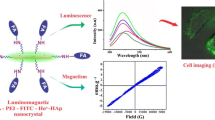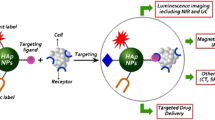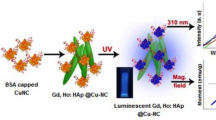Abstract
Hen’s eggshell, a biological waste product, was turned into a cell imaging probe: europium doped hydroxyapatite (HAp: Eu) nanoparticle using hydrothermal method. Luminescence of the synthesized nanoparticle was studied for various doping concentrations of the lanthanide ion europium (Eu3+). Eu doped HAp showed a hexagonal crystal structure and rod-shaped morphology. Well-defined emission peaks of europium, corresponding to the substitution of Eu3+ at the Ca2+(I) site of HAp, were confirmed from the samples’ photoluminescence (PL) spectra. Good biocompatibility up to 500 μg/mL of the samples indicates their potential applications in bioimaging. Synthesized nanoparticles were internalized and used for in vitro imaging of the PC12 cells without any surface modification. The materials’ use as a potential in vivo imaging agent is proposed from the haemolysis study.
Graphical Abstract











Similar content being viewed by others
Availability of Data and Material
The data provided in the manuscript is original and will be made available at any time on a request basis.
References
Liu H, Chen F, Xi P et al (2011) Biocompatible fluorescent hydroxyapatite: Synthesis and live cell imaging applications. J Phys Chem C 115:18538–18544. https://doi.org/10.1021/jp206843w
Xie Y, He W, Li F et al (2016) Luminescence enhanced Eu 3+ /Gd 3+ co-doped hydroxyapatite nanocrystals as imaging agents in vitro and in vivo. ACS Appl Mater Interfaces 8:10212–10219. https://doi.org/10.1021/acsami.6b01814
Demchenko AP (2013) Nanoparticles and nanocomposites for fluorescence sensing and imaging. Methods Appl Fluoresc 1:022001–022028. https://doi.org/10.1088/2050-6120/1/2/022001
Hoshyar N, Gray S, Han H, Bao G (2016) The effect of nanoparticle size on in vivo pharmacokinetics and cellular interaction. Nanomedicine 11:673–692. https://doi.org/10.2217/nnm.16.5
Foroozandeh P, Aziz AA (2018) Insight into cellular uptake and intracellular trafficking of nanoparticles. Nanoscale Res Lett 6:1–12. https://doi.org/10.1186/s11671-018-2728-6
Karthik V, Pabi SK, Roy Chowdhury SK (2018) Development of hydroxyapatite / polyvinyl alcohol bionanocomposite for prosthesis implants. IOP Conf Ser Mater Sci Eng 314:012031. https://doi.org/10.1088/1757-899X/314/1/012031
Rivera EM, Araiza M, Brostow W et al (1999) Synthesis of hydroxyapatite from eggshells. Mater Lett 41:128–134. https://doi.org/10.1016/S0167-577X(99)00118-4
Kumar GS, Girija EK (2013) Flower-like hydroxyapatite nanostructure obtained from eggshell: A candidate for biomedical applications. Ceram Int 39:8293–8299. https://doi.org/10.1016/j.ceramint.2013.03.099
Hasna K, Kumar SS, Komath M et al (2013) Synthesis of chemically pure, luminescent Eu3+ doped HAp nanoparticles: A promising fluorescent probe for in vivo imaging applications. Phys Chem Chem Phys 15:8106–8111. https://doi.org/10.1039/c3cp42648c
Prabakaran K, Balamurugan A, Rajeswari S (2005) Development of calcium phosphate based apatite from hen’s eggshell. Bull Mater Sci 28:115–119. https://doi.org/10.1007/BF02704229
Lee SJ, Chun SY (2005) Fabrication of calcium based fine ceramic materials by recycling eggshell. Mater Sci Forum 486–487:293–296. https://doi.org/10.4028/www.scientific.net/msf.486-487.293
Bal C, Ferenc W, Zsuzsanna K (2007) Preparation of calcium – phosphate bioceramics from natural resources. J Eur Ceram Soc 27:1601–1606. https://doi.org/10.1016/j.jeurceramsoc.2006.04.016
Gergely G, Wéber F, Lukács I et al (2010) Preparation and characterization of hydroxyapatite from eggshell. Ceram Int 36:803–806. https://doi.org/10.1016/j.ceramint.2009.09.020
Adeogun AI, Ofudje AE, Idowu MA, Kareem SO (2018) Facile development of nano size calcium hydroxyapatite based ceramic from eggshells: Synthesis and Characterization. Waste and Biomass Valorization 9:1469–1473. https://doi.org/10.1007/s12649-017-9891-3
Silva FRO, De Lima NB, Bressiani AHA et al (2015) Synthesis, characterization and luminescence properties of Eu3+-doped hydroxyapatite nanocrystal and the thermal treatment effects. Opt Mater (Amst) 47:135–142. https://doi.org/10.1016/j.optmat.2015.07.006
Han Y, Wang X, Li S (2010) Biocompatible europium doped hydroxyapatite nanoparticles as a biological fluorescent probe. Curr Nanosci 6:178–183. https://doi.org/10.2174/157341310790945632
Ciobanu CS, Iconaru SL, Massuyeau F et al (2012) Synthesis, structure, and luminescent properties of europium-doped hydroxyapatite nanocrystalline powders. J Nanomater 2012:1–9. https://doi.org/10.1155/2012/942801
Sun R, Chen K, Wu X et al (2013) Controlled synthesis and enhanced luminescence of europium-doped fluorine-substituted hydroxyapatite nanoparticles. CrystEngComm 15:3442–3447. https://doi.org/10.1039/c3ce26973f
Hui J, Zhang X, Zhang Z et al (2012) Fluoridated HAp:Ln3+ (Ln = Eu or Tb) nanoparticles for cell-imaging. Nanoscale 4:6967–6970. https://doi.org/10.1039/c2nr32404k
Earl JS, Wood DJ, Milne SJ (2006) Hydrothermal synthesis of hydroxyapatite. J Phys Conf Ser 26:268–271. https://doi.org/10.1088/1742-6596/26/1/064
Jayasree R, Madhumathi K, Rana D et al (2018) Development of egg shell derived carbonated apatite nanocarrier system for drug delivery. J Nanosci Nanotechnol 18:2318–2324. https://doi.org/10.1166/jnn.2018.14377
Azis Y, Adrian M, Alfarisi CD et al (2018) Synthesis of hydroxyapatite nanoparticles from egg shells by sol-gel method. IOP Conf Ser Mater Sci Eng 345:012040. https://doi.org/10.1088/1757-899X/345/1/012040
Wati R, Yusuf Y (2019) Carbonated Hydroxyapatite Derived from Cerastoderma edule, Paphia undulata, and Meretrix meretrix Shells. IOP Conf Ser Mater Sci Eng 546:1–8. https://doi.org/10.1088/1757-899X/546/4/042049
Piriou B, Fahmi D, Dexpert-Ghys J et al (1987) Unusual fluorescent properties of Eu3+ in oxyapatites. J Lumin 39:97–103. https://doi.org/10.1016/0022-2313(87)90036-6
Karbowiak M, Hubert S (2000) Site-selective emission spectra of Eu3+ :Ca5 (PO)4 F. J Alloys Compd 302:87–93. https://doi.org/10.1016/S0925-8388(00)00612-5
Zeng H, Li X, Xie F, Chen H (2014) Dextran-coated fluorapatite nanorods doped with lanthanides in labelling and directing osteogenic di ff erentiation of bone marrow mesenchymal stem. J Mater Chem B 2:3609–3617. https://doi.org/10.1039/c4tb00303a
Geng Z, Cheng Y, Ma L et al (2017) Nanosized strontium substituted hydroxyapatite prepared from egg shell for enhanced biological properties. J Biomater Appl 1–10 https://doi.org/10.1177/0885328217748124
Iconaru SL, Motelica-Heino M, Predoi D (2013) Study on europium-doped hydroxyapatite nanoparticles by fourier transform infrared spectroscopy and their antimicrobial properties. J Spectrosc 2013:1–4. https://doi.org/10.1155/2013/284285
Sadat-Shojai M, Khorasani MT, Dinpanah-Khoshdargi E, Jamshidi A (2013) Synthesis methods for nanosized hydroxyapatite with diverse structures. Acta Biomater 9:7591–7621. https://doi.org/10.1016/j.actbio.2013.04.012
Sun Y, Yang H, Tao D (2012) Preparation and characterization of Eu 3+ -doped fluorapatite nanoparticles by a hydrothermal method. Ceram Int 38:6937–6941. https://doi.org/10.1016/j.ceramint.2012.05.036
Yang P, Quan Z, Li C et al (2008) Bioactive, luminescent and mesoporous europium-doped hydroxyapatite as a drug carrier. Biomaterials 29:4341–4347. https://doi.org/10.1016/j.biomaterials.2008.07.042
Ignjatović NL, Mančić L, Vuković M et al (2019) Rare-earth (Gd3+, Yb3+/Tm3+, Eu3+) co-doped hydroxyapatite as magnetic, up-conversion and down-conversion materials for multimodal imaging. Sci Rep 9:1–15. https://doi.org/10.1038/s41598-019-52885-0
Luo X, Luo X, Wang H et al (2018) Synthesis, structure and temperature dependent luminescence of Eu3+ doped hydroxyapatite. IOP Conf Ser Mater Sci Eng 284:012004. https://doi.org/10.1088/1757-899X/284/1/012004
Parchur AK, Ningthoujam RS (2012) Behaviour of electric and magnetic dipole transitions of Eu3+, 5D0 A 7F0 and Eu–O charge transfer band in Li+ co-doped YPO4:Eu3+. RSC Adv 2:10859–10868. https://doi.org/10.1039/c2ra22144f
Wang R, Zhang F (2016) Lanthanide-based near infrared nanomaterials for bioimaging. In: RSC Nanosci Nanotechnol 1–39. https://doi.org/10.1039/9781782623199-00001
Xuan T, Ngoc N, Pham V (2015) Comparative characterization of microstructure and luminescence of europium doped hydroxyapatite nanoparticles via coprecipitation and hydrothermal method. Opt - Int J Light Electron Opt 126:5019–5021. https://doi.org/10.1016/j.ijleo.2015.09.136
Gaft M, Reisfeld R, Panczer G et al (1997) Eu3+ luminescence in high-symmetry sites of natural apatite. J Lumin 72–74:572–574. https://doi.org/10.1016/S0022-2313(96)00229-3
Liu H, Wang L, Chen S, Zou B (2008) Optical properties of nanocrystal and bulk ZrO2: Eu3+. J Alloys Compd 448:336–339. https://doi.org/10.1016/j.jallcom.2006.11.171
Yang P, Deng P, Yin Z (2002) Concentration quenching in Yb:YAG. J Lumin 97:51–54. https://doi.org/10.1016/S0022-2313(01)00426-4
Reisfeld R (1973) Spectra and energy transfer of rare earths in inorganic glasses. In: Structure and bonding book series. Springer, pp 53–98. https://doi.org/10.1007/3-540-06125-8_2
Gutzov S, Kohls M, Lerch M (2000) The luminescence of Zr – Eu – O – N materials. J Phys Chem Solids 61:1301–1309. https://doi.org/10.1016/S0022-3697(99)00406-0
Yu S, Ping Y, Yi L et al (2008) Isolation and characterization of cancer stem cells from a human glioblastoma cell line U87. Cancer Lett 265:124–134. https://doi.org/10.1016/j.canlet.2008.02.010
Weber S, Fernandez-Cachon ML, Nascimento JM et al (2013) Label-free detection of neuronal differentiation in cell populations using high-throughput live-cell imaging of PC12 Cells. PLoS One 8:1–10. https://doi.org/10.1371/journal.pone.0056690
Salto R, Vílchez JD, Girón MD et al (2015) β -Hydroxy- β -Methylbutyrate ( HMB ) Promotes neurite outgrowth in neuro2a cells. PLoS One 10:1–13. https://doi.org/10.1371/journal.pone.0135614
Reichman J (2012) Handbook of optical filters for fluorescence microscopy. Chroma technology corp
Wu Y, Shi M, Zhao L et al (2014) Visible-light-excited and europium-emissive nanoparticles for highly-luminescent bioimaging in vivo. Biomaterials 35:5830–5839. https://doi.org/10.1016/j.biomaterials.2014.03.080
Acknowledgements
This work was funded by Kerala State Council for Science, Technology and Environment (KSCSTE) under the KSCSTE Research fellowship scheme. The author T. K. Krishnapriya acknowledges STIC-CUSAT for TEM measurement, DST FIST for the FeSEM facility at the Department of Physics, CUSAT and Rosamma Varghese (MES College, Nedumkandam) for the help during sample preparation.
Funding
This work was funded by Kerala State Council for Science, Technology and Environment (KSCSTE) under the KSCSTE Research fellowship scheme.
Author information
Authors and Affiliations
Contributions
T. K. Krishnapriya: Conceptualization, Methodology, Investigation, Writing-Original draft preparation Ayswaria Deepti: Methodology, Investigation, Validation P. S. Baby Chakrapani: Supervision, Writing- Reviewing and editing A. S. Asha: Supervision, Writing- Reviewing and editing M. K. Jayaraj: Conceptualization, Supervision, Resources, Writing- Reviewing and Editing.
Corresponding author
Ethics declarations
Ethical Approval
This is to certify that the article entitled “Eggshell derived europium doped hydroxyapatite nanoparticles for cell imaging application” submitted by T K Krishnapriya et al., for the publication in Journal of Fluorescence is based on the original work and results of the experiments were carried out by all authors under my supervision. No part of the article has been previously submitted for the publication in any other journals.
Consent for Publication
The authors give consent for the publication.
Conflicts of Interest
The authors declare that they have no known competing financial interests or personal relationships that could have appeared to influence the work reported in this paper.
Additional information
Publisher's Note
Springer Nature remains neutral with regard to jurisdictional claims in published maps and institutional affiliations.
Supplementary Information
Below is the link to the electronic supplementary material.
Rights and permissions
About this article
Cite this article
Krishnapriya, T.K., Deepti, A., Chakrapani, P.S.B. et al. Eggshell Derived Europium Doped Hydroxyapatite Nanoparticles for Cell Imaging Application. J Fluoresc 31, 1927–1936 (2021). https://doi.org/10.1007/s10895-021-02814-0
Received:
Accepted:
Published:
Issue Date:
DOI: https://doi.org/10.1007/s10895-021-02814-0




